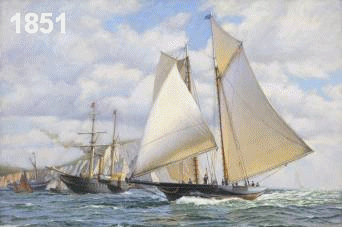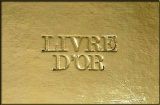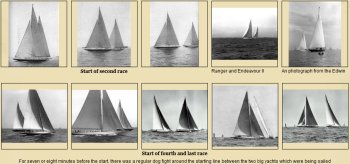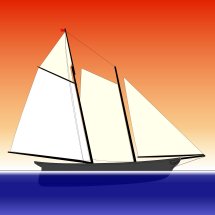 AMERICA'S CUP
AMERICA'S CUP1851-1937
"If we can fly today in the San Francisco Bay, this is because there have been "adventurers" like Walter Greene and Mike Birch.
To understand the future, we must know and respect the past."
Loïck PEYRON (Voiles et Voiliers July 2014)
![]()










 Few photos for this edition of 1937. Perhaps because of the crisis, Ranger has not had the success he deserved, whether in the selection trials than for the Cup matches or in regattas after the Cup.
Few photos for this edition of 1937. Perhaps because of the crisis, Ranger has not had the success he deserved, whether in the selection trials than for the Cup matches or in regattas after the Cup.
 THURSDAY, JULY 22, 1920
THURSDAY, JULY 22, 1920

 The Final Voyage of the Portland
The Final Voyage of the Portland Captain Urias Rhodes was born in Bay Shore, Long Island, on February 23, 1852. He was the son of Richard Rhodes, whose father, William Rhodes, lived in Rockaway before coming to Bay Shore. William was four times married and had 13 children. Richard was the only child of the union of William and Elizabeth Brower. Richard was born in Bay Shore on December 8, 1827, and died September 6, 1916. He married Selina L'Hommedieu on January 28, 1851.
Captain Urias Rhodes was born in Bay Shore, Long Island, on February 23, 1852. He was the son of Richard Rhodes, whose father, William Rhodes, lived in Rockaway before coming to Bay Shore. William was four times married and had 13 children. Richard was the only child of the union of William and Elizabeth Brower. Richard was born in Bay Shore on December 8, 1827, and died September 6, 1916. He married Selina L'Hommedieu on January 28, 1851. A self-taught artist of the Liverpool School, John Hughes was born in that seafaring town in 1806. He was a very competent marine painter, the majority of whose works were done for export to America. It is interesting to note that of all the known works by John Hughes only a very few survive in his native England.
A self-taught artist of the Liverpool School, John Hughes was born in that seafaring town in 1806. He was a very competent marine painter, the majority of whose works were done for export to America. It is interesting to note that of all the known works by John Hughes only a very few survive in his native England. Blessed with an inherited passion for maritime subjects through his family’s nautical heritage, the art of Shane Couch harkens back to the works of the finest 19th century marine artists. The subject he holds in the highest regard and has in common with artists such as James E. Buttersworth, Thomas Hoyne and Montague Dawson: yesteryear’s greatest sailing yachts.
Blessed with an inherited passion for maritime subjects through his family’s nautical heritage, the art of Shane Couch harkens back to the works of the finest 19th century marine artists. The subject he holds in the highest regard and has in common with artists such as James E. Buttersworth, Thomas Hoyne and Montague Dawson: yesteryear’s greatest sailing yachts.

